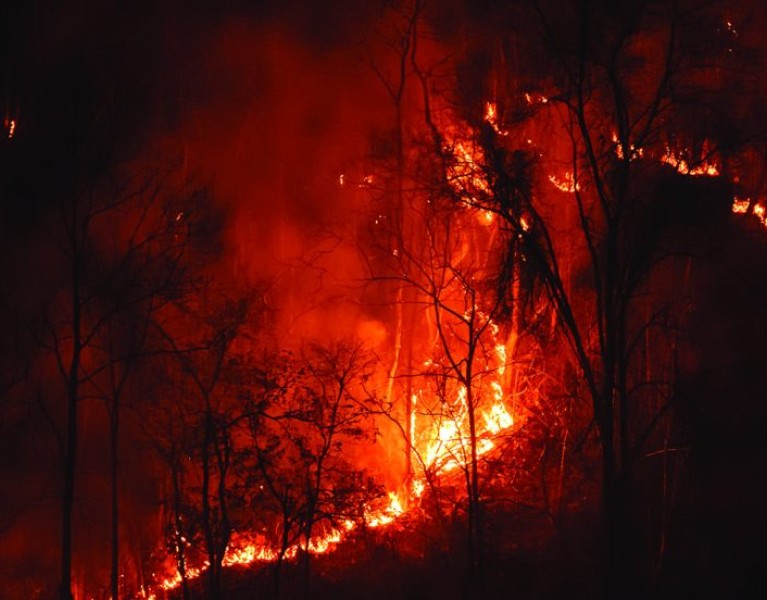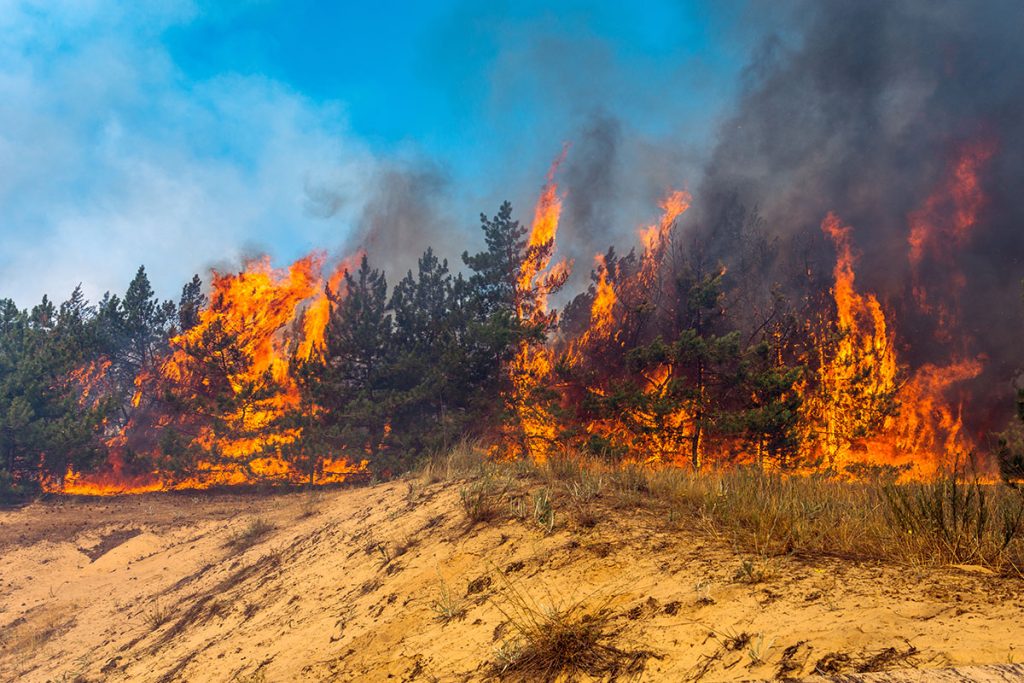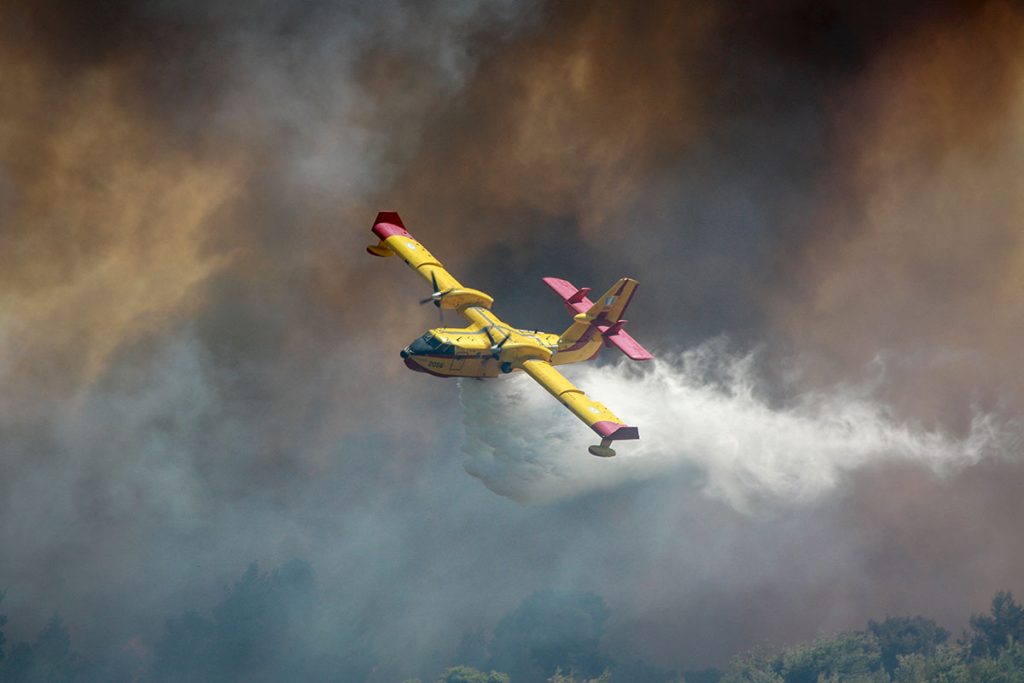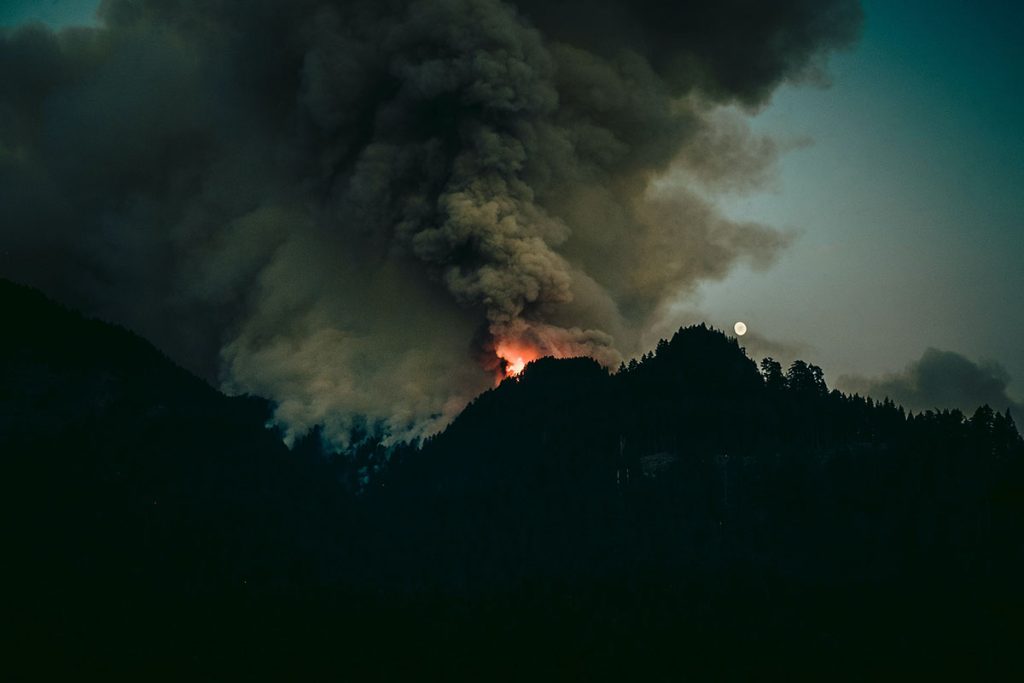- 1. Wildfire Safety Tips
- 1.1. Other wildfire safety tips include:
- 1.2. Bookmark InciWeb
- 2. How to Survive a Wildfire
- 2.1. Other wildfire survival tips include:
- 3. What to Do When Caught in a Wildfire
- 4. Where and When Do Wildfires Happen
- 5. Travel With the Right Gear
- 6. Pack the Right Clothing
- 7. Stay Safe, So You Can Stay Chill in the Heat

The Adventurer's Guide to Wildfire Season
Table of Contents [Show]
With forests, shrubland, and grassland covering over half of the land area in the United States, it’s no wonder that we love getting out and exploring nature. But with these ecosystems comes the real danger of wildfires. A wildfire can happen anywhere at any time, with peak wildfire season typically occurring from June through August. Unfortunately, multiple studies have shown that climate change has led to an increase in wildfire season length, frequency and areas burned.
Traveling during wildfire season can be extremely dangerous if you’re unaware of your surroundings and unprepared for such an event. Wildfires rage through forests and towns with an untamable force that can quickly turn into complete chaos. If you’re from an area where wildfires aren’t common and you plan on taking a trip to an area prone to fires, it’s a good idea to educate yourself on wildfire safety and survival tips.
Wildfire Safety Tips
You’ve seen those signs: Smokey Bear holding a cute, multi-colored graph indicating fire danger levels. Those signs are great for raising awareness, but they don’t inform National Forest visitors when official fire restrictions limit access and activities. And they don’t provide pertinent safety tips.
The first thing you should do is download and print off a few copies of the U.S. Forest Service (USFS) guide to fire restriction stages. It’s helpful to keep a copy in your glove box and one in your pack for quick reference. At Stage One, minor restrictions are imposed such as smoking and building a fire outside specified areas. At Stage Two the risk of fire is increased and more restrictions are put in place. Stage Three is closure, no one is allowed to access the area in danger. Before going hiking or camping, check with the forest ranger for fire restrictions or area closures.

Other wildfire safety tips include:
- Plan ahead and prepare — know your route, and tell a responsible adult where you are going and when you plan to return.
- Sign in at the trailhead.
- Use alternatives to campfires during periods of high fire danger, even if there are no restrictions. Nine out of 10 fires are caused by humans.
- If you do use a campfire, make sure it is fully extinguished before leaving the area — be sure it is cold to the touch.
- If you are using a portable stove, make sure the area is clear of grasses and other debris that may catch fire. Prevent stoves from tipping and starting a fire.
- Practice Leave No Trace principles — pack out cigarette butts and burned materials from your camping area.
- Beware of sudden changes in the weather or changing weather conditions. For example, if you see a thunderstorm approaching, consider leaving the area. Fires started by lightning strikes are not unusual.
- If you see smoke, fire, or suspicious activities, note the location as best you can and report it to authorities. Call the National Fire Information Center or 911.
- DO NOT attempt to put out a fire by yourself.
- Be careful of parking or driving your car or ATV in tall, dry, vegetation, such as grass. The hot underside of the vehicle can start a fire.
- Keep at least 2 gallons of water nearby and never leave a fire unattended.
- Never set off fireworks during wildfire season.
- Consider carrying an N95 or N100 disposable respirator with you in case you get caught in heavy smoke.
- Always acquire the needed permits to have a campfire or use a portable stove.
Bookmark InciWeb
Another great resource for the most up-to-date wildfire data is InciWeb. It’s your one-stop shop for nationwide fire information. It was created to provide a single source of incident-related data and closure/evacuation information. Also available are news releases, important announcements, maps, photos, and videos of wildfire activity.
How to Survive a Wildfire
If you find yourself near a wildfire you’ll want to get out of that area as fast as possible without panicking. The best way to retreat calmly and safely is by having a plan. The first step in your plan should include packing a hard-copy topo map showing secondary roads. Bring along a compass, too, as you may not have any service in the forest. Read the map before your journey, familiarize yourself with the area and create an evacuation plan. Choose a route that has multiple points of exit, and try to avoid one-ways or dead ends. This is an important step as something this simple could save your life.

Other wildfire survival tips include:
- Fire travels uphill, so you should head down.
- When possible, stay upwind of the fire.
- Head around the back of a fire, traveling through burned (black) zones as soon as they’re cool enough to walk through.
- Stay close to established roads whenever you can, or follow watersheds.
- Avoid brushy creek beds and heat-trapping arroyos.
- Watch for spot fires caused by embers.
What to Do When Caught in a Wildfire
If you find yourself in the unfortunate situation of being caught in a wildfire, there are a few things you can do to stay alive. First, get out of the open area and find shelter. Any non-combustible shelter will help protect you. Look for a crevasse under a large boulder or a ditch to lie down in. If in a ditch, dig out an impression and lie prone. Dig a deeper hole to place your face, keeping it cool and giving yourself an air pocket. Remember to keep your body as close to the ground as possible. You can also use a wet bandana to cover your mouth as a temporary respirator.
If you’re caught driving on the road with nowhere to go, follow these recommendations:
- Park off the road in a clear area away from trees, scrub and tall grass.
- Face the front of your car towards the fire.
- Stay in the car below the windows to protect yourself from radiant heat.
- Turn off the engine and turn on headlights and hazard lights.
- Close windows and air vents.
- Cover yourself with a woolen blanket.
- Drink plenty of water.
- Cover your mouth with a damp cloth.
- Stay down until the sound of the fire has passed, then carefully leave the car (it will be hot).
Important Note: Check for severed power lines and burned, unstable trees and utility poles as you leave your car, and don’t let your kids or pets walk on hot asphalt or ash.
Where and When Do Wildfires Happen
Wildfires happen all over the country. They are more common in the East, but they are much larger and burn more acreage in the West. California, Oregon, Alaska, and Idaho are all states at high risk with areas that have experienced terrible damage due to wildfires.
A wildfire can happen anywhere at any time. Peak wildfire season in the United States typically occurs from June through August, but global warming and more human activity have created a longer and more unpredictable wildfire season.

Travel With the Right Gear
Let’s start out with the items you should always have on hand: Your first aid kit, a layered means of obtaining drinking water, a headlamp (and extra batteries), and anything else recommended in “Put Some Gray Matter in Your Backcountry Emergency Kit. And then, these:
- Wool blanket
- A shovel (preferably travel-size)
- N95 or N100 masks
- Durable, thick-soled footwear
- Safety goggles
Pack the Right Clothing
For all the same reasons cotton clothing isn’t trail-friendly, it’s nearly ideal attire for fleeing a fire. Synthetic fibers melt, burn, and bonding to the skin. (Remember that time you set that sap-encrusted log on a campfire? So long, favorite fleece sweater!) Natural fibers like wool, cotton, and hemp retain moisture and don’t ignite nearly as easily when they come into contact with falling embers. Plus, in a pinch, a wet cotton shirt or bandana can temporarily serve as a respirator, both cooling and filtering hot, particulate-filled air.
By all means, pack your long-sleeved hemp, cotton, or Merino wool tops, and comfortable, lightweight, full-length pants. And don’t forget wool socks to protect your feet.
Stay Safe, So You Can Stay Chill in the Heat
Wildfires are incredibly dangerous, but you can be prepared by following this guide. Always stay updated with the weather conditions, and bring proper gear with you when in an area of high risk. There are plenty of reasons to panic if you’re ever caught in a wildfire, but the best thing to do is stay calm and critically think about your next move. Follow the tips above, stay safe and enjoy your time in the forest!
Featured image by: nuwatphoto.


